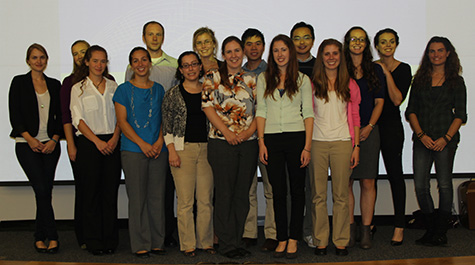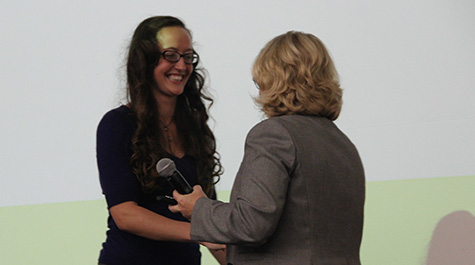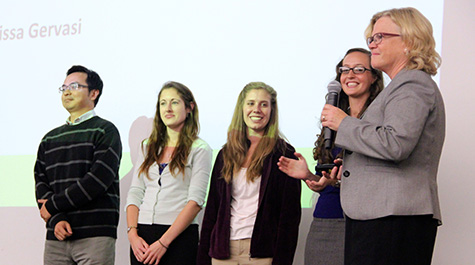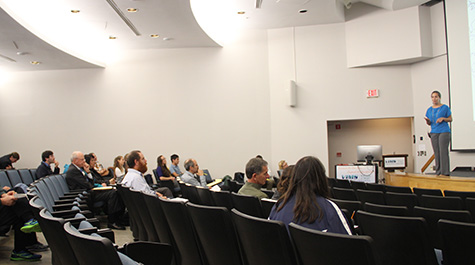VIMS announces winner of Three Minute Thesis competition
Graduate student Lydia Bienlien of the Virginia Institute of Marine Science won first-place during VIMS’ inaugural Three Minute Thesis® competition for her description of the “secret triad” that affects the health of oysters and the people who eat them.
Bielien explained—in 2 minutes and 56 seconds—how her research aims to unveil whether the Eastern oyster Crassostrea virginica, the oyster parasite Perkinsus marinus, and two oyster-infecting bacteria within the genus Vibrio interact and how they might affect one another.
Understanding this relationship, she says, could help enhance the mid-Atlantic’s rapidly expanding oyster aquaculture industry, while also aiding efforts to restore wild oyster reefs for improved habitat and water quality.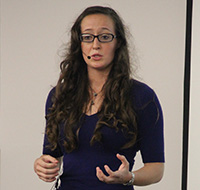
Bienlien was 1 of 18 graduate students from William & Mary’s School of Marine Science at VIMS who presented their research during the Institute’s first-ever 3MT® competition. Established by The University of Queensland (UQ) in 2008, 3MT® is now held in universities around the globe. The competition helps graduate students hone their ability to communicate the importance of their research to a public audience in a succinct and engaging manner.
The VIMS competition kicked-off with an initial round in which each of the students described their research project in three minutes or less to an audience of faculty, staff, fellow students, and members of the public. Topics ranged from striped bass disease in Chesapeake Bay to plankton community structure off Bermuda to strategies for improving coastal-flood resilience in the Mid-Atlantic.
“All of the students did a phenomenal job of communicating the importance of their research to a non-specialist audience,” says VIMS Associate Dean of Academic Studies Linda Schaffner, the event’s organizer. “Each student excelled at representing their individual departments, and explaining the impact their research has on the lives of the audience members.”
Bienlien says it’s important for graduate students to enhance their communication skills, so that non-scientists can understand and appreciate the significance of their studies. “This competition helps students focus on the major impacts of their research, while allowing non-experts to become familiar with it at the same time,” she says.
“It takes a great deal of effort to narrow down very complex research projects into just three minutes, especially when explaining it to an audience who is relatively unfamiliar with what you study,” says Schaffner. “We’re proud of all of our students for welcoming the challenge and delivering engaging and entertaining presentations.”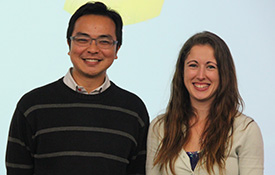
Following the initial presentations, a panel of judges chose six students to advance to a final round in which the selected speakers gave their presentations a second time. The first- and second-place winners were then determined by a different panel of judges, while the audience voted to select two recipients of a "People's Choice" award.
Second place in the competition was a tie, recognizing the accomplishments of both Tin Chi Solomon Chak (The Evolution of Eusociality in Snapping Shrimps) and Carissa Gervasi (Battling a Deadly Disease: What Will Happen to the Striped Bass?). Winners of the People’s Choice Award were Bienlien and fellow graduate student Jami Ivory (Drifters of the Bermuda Triangle).
Bielien says the most challenging aspect of the competition was memorizing her speech. “It seems like three minutes really isn’t very long, but when you want to get each word perfect to make the speech flow, memorizing it can be difficult,” she says. “I’m thankful for my co-workers, friends, and my advisor Dr. Ryan Carnegie for their willingness to listen to me go over it again and again.”
Judges in the final round included VIMS Dean and Director John Wells, W&M’s Executive Director of Corporate and Foundation Relations Annie Davis and Associate Vice President for Communications and University Relations Brian Whitson, President and CEO of VersAbility Resources Kasia Grzelkowski, Assistant Branch Head of Aerothermodynamics at NASA Langley Research Center Kelly Murphy, and Counsel for McGuire Woods R. Gordon Smith.
Judges for the initial round were VIMS Development Director Amy Fisher; VIMS Communications Director David Malmquist; Marine Education Program Leader Lisa Lawrence, VIMS extension staff affiliated with Virginia Sea Grant; W&M Professor Gail Hardinge, W&M Director of Research Communications Joe McClain, and W&M Director of Communications for Arts and Sciences Steve Otto.
Presenters and Topics
- Lisa Ailloud: Scaling Back and Moving Forward: Improving the Chance of a Bluefin Tuna Recovery
- Lydia Bienlien: The Secret Triad
- Tin Chin Solomon Chak: Evolution of Eusociality in Snapping Shrimps
- Emily French: Seagrass: Big Things Come in Small Packages
- Carissa Gervasi: Battling a Deadly Disease: What Will Happen to the Striped Bass?
- Cassandra Glaspie: Living in a Crab Eat Clam World: Bivalve Predator-Prey Interactions in the Chesapeake Bay
- Quang Huynh: Size Matters: Assessing Fish Populations Using Average Size of Catch
- Jami Ivory: Drifters of the Bermuda Triangle
- Melissa Karp: Making an Oyster Reef a Good Place to Live and Feed
- Nadya Mamoozadeh: Population Structure in a Highly Migratory Species
- Julia Moriarty: Dead Zones: Who Stole the Oxygen?
- Alex Renaud: Coastal Community Flood Resilience Measures
- Lucia de Souza Lima Safi: Ciliates and Epibiosis: What does it have to do with the Chesapeake Bay?
- Erika Schmitt: Bay scallops: They’re What’s for Dinner
- Xiaoteng Shen: Modeling Flocculation and Deflocculation Processes of Cohesive Sediments
- Jenna Spackeen: Bloom or Doom: Some Like it Hot, and Some do Not
- Joshua Stone: Jell-O shots: Jellyfish Carbon-Bombing of the Seafloor
- Haixing Daniel Wang: Physical Oceanography Near Shelf-break Submarine Canyons


